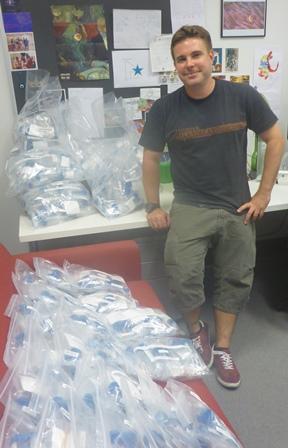Northern NSW fishing clubs are encouraging their members to become citizen scientists as part of the first ever study into the presence of toxins (CTXs), that cause the serious seafood-borne illness ciguatera fish poisoning (CFP), in fish caught in NSW waters.

Dr Olivier Laczka and Associate Professor Shauna Murray, from the UTS Plant Functional Biology and Climate Change Cluster (C3), are enlisting the aid of recreational fishers between Coffs Harbour and Byron Bay with the aim of gathering data that will help determine if the toxins are present in Spanish mackerel, a fish popular with recreational fishers and associated with CFP.
“These toxins are naturally produced by marine microalgae and bio-accumulate in both the fish that graze on the algae as well as the predator fish that feed on them. Humans, at the end of this food web, contract CFP by eating carnivorous fish such as Spanish mackerel,” Dr Laczka says.
Although CFP is generally associated with tropical waters Associate Professor Murray, a world expert on CFP, has detected the toxin in algae collected in the temperate waters off the NSW South Coast. In 2014 outbreaks of the illness caused by eating fish caught in Northern NSW waters resulted in the NSW DPI recommending that Spanish mackerel (Scomberomorus commerson) over 10kg not be kept for human consumption. The larger the fish the more toxin it accumulates - freezing and cooking processes do not degrade the toxin.
“However, there is no data from NSW on the size of susceptible fish, or where they were caught. We aim to establish the first CTX testing facility in NSW and recreational fishers will be helping unlock the secrets to a problem that is on the rise worldwide,” Dr Laczka added.
The toxin producing microalgae (Gambierdiscus spp) seem to thrive in environments undergoing environmental disturbance making coral reef and seagrass ecosystems, as well as the humans who rely on them for food, especially vulnerable. As oceans continue to warm scientists and fisheries experts are concerned that more reef dwelling migratory fish, such as Spanish mackerel, caught in temperate waters, will have bio-accumulated CTX.
The UTS scientists have received an enthusiastic response from organisations such as the Coffs Harbour Deep Sea Fishing Club, handing out sampling kits and guides and answering questions about the impact of CFP. Fishers have been asked to collect samples of flesh and liver from Spanish mackerel and record the size, weight, location and date of the catch.
The year-long research project is being funded by the NSW DPI, through the Recreational Fishing Trust, and the Australian Government Fisheries research and Development Corporation.
Olivier is a member of the C3 Coastal Oceanography and Algal Research Team, Shauna leads the C3 Seafood Safety Program.

